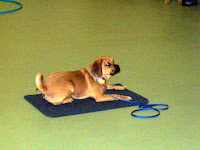 Now that spring is here it's time to dust off your winter cobwebs as well as your dog's and get your 'mojo' on again! We all feel better and have more spark when spring rolls around and that includes our dogs. The newness of spring can lure any dog to explore the fresh and heightened scents in the air and the milder temperatures can encourage wandering just a bit farther off the path to investigate the sights and sounds of the environment. The bad news is these intense environmental distractions can make it appear that your dog has noooooo! idea how to walk politely on lead, sit when asked, or come when called. The good news is that by incorporating some training variety or as I like to call it - "changing the picture" - you can help your dog learn to respond quickly and eagerly wherever you are.
Now that spring is here it's time to dust off your winter cobwebs as well as your dog's and get your 'mojo' on again! We all feel better and have more spark when spring rolls around and that includes our dogs. The newness of spring can lure any dog to explore the fresh and heightened scents in the air and the milder temperatures can encourage wandering just a bit farther off the path to investigate the sights and sounds of the environment. The bad news is these intense environmental distractions can make it appear that your dog has noooooo! idea how to walk politely on lead, sit when asked, or come when called. The good news is that by incorporating some training variety or as I like to call it - "changing the picture" - you can help your dog learn to respond quickly and eagerly wherever you are. To create a dog who is ready, willing, and able to respond to your cues whenever and wherever you are you must train in as many novel environments as possible. It will be essential that you start small and manage the situation as best as you can in order to create success for your dog and you. Here are some tips to change Distracted Daisy into Responsive Roxie.
Make it as easy as possible for your dog to be successful. Don't be afraid to use a food lure to get the behavior at first - a little help is perfectly okay. Reinforce easier steps such as looking at you or taking a step toward you. Make sure the distractions aren't too big and/or too numerous at first. For example, practice in your front yard before trying it in the park.
2. Use higher value reinforcement.
Pick an extra scrumptious treat or other activity that your dog will do back flips to earn. He'll be more likely to respond in a novel environment when the reward is worth the effort of ignoring the distraction. The interest will often change from situation to situation so have a variety to pick from.
 3. Set realistic expectations.
3. Set realistic expectations.Your dogs age and breed will play a part in your success rate. One year old Pearl the Poodle may shine when a ball rolls by but 6 month old Barney the Beagle will likely have big trouble when a squirrel crosses his path.
4. Give Bonus Bones.
Learning is hard work so offer extra treats or a special play session for a job well done!
5. Use what the dog wants to get what you want.
This can be very effective in getting your dog to respond in the face of a distraction. This is used frequently with children - you clean up your room first and you can go play with your friends. It can work equally well with your dog - if your dog lies down for you first, he gets to play with his doggy friends; if he comes to you away from a jogger, he gets to play a game of fetch.
6. Provide lots of training opportunities.
The more you practice, the better your dog and you become. When you allow a variety of training situations with a variety of distractions you will begin to see your dog responding more quickly each time. The more opportunities you provide, the more quickly your dog will begin to "generalize" his behaviors.
7. Make it fun!
Remember to smile, laugh, and enjoy this time with your dog. If training isn't fun for you, it won't be fun for your dog. He'll be more likely to find the environment interesting and be less responsive to you.
The key is to practice as often as possible in the big, wide, wonderful world. The more training variety you provide, the better your dog will get at responding to you and the better you will get at knowing how to get your dog to respond to you rather than the environment. Soon you'll develop an awareness and connection between you and your dog that will amaze you and make you proud of your dog and proud of your hard work.
So, don't delay - get up, get out and about, get training!


No comments:
Post a Comment